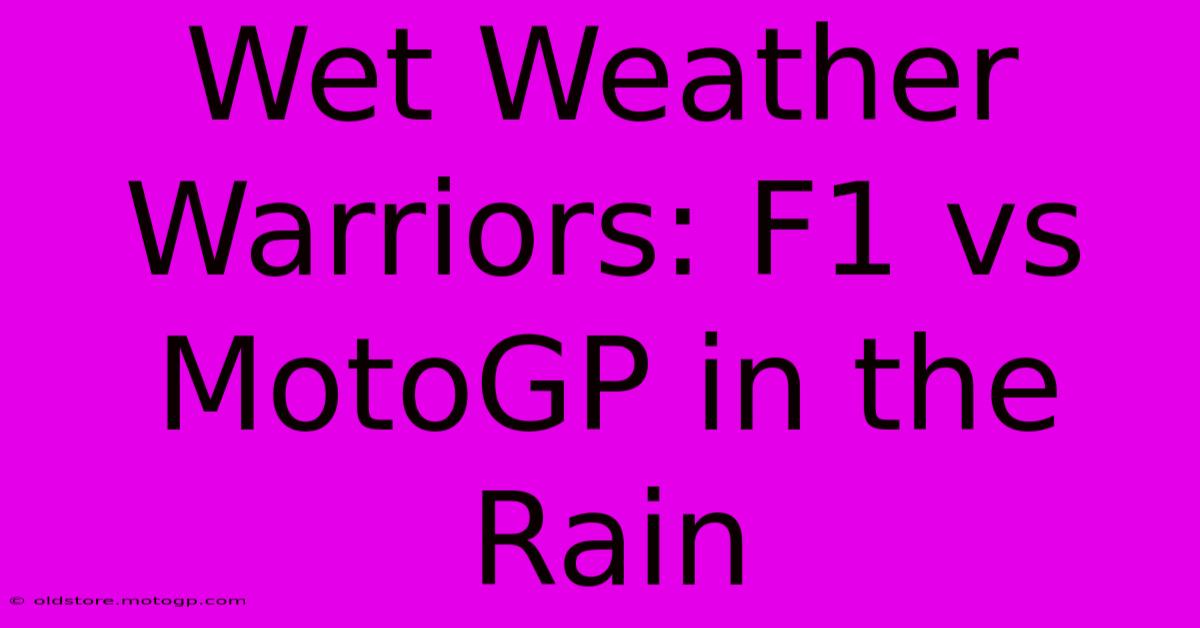Wet Weather Warriors: F1 Vs MotoGP In The Rain

Table of Contents
Wet Weather Warriors: F1 vs MotoGP in the Rain
The roar of the engines, the spray of water, the sheer nerve-wracking tension – rain races in both Formula 1 and MotoGP are spectacles unlike any other. But while both feature the world's best drivers battling treacherous conditions, the approaches, challenges, and even the drama are vastly different. This article dives deep into the contrasting worlds of wet-weather racing in F1 and MotoGP, exploring the unique skills, technology, and sheer guts required to conquer the elements.
The Machines: A Tale of Two Wheels and Four
The fundamental difference lies in the machines themselves. F1 cars, with their substantial downforce, are designed for grip, even in the dry. However, this downforce becomes a double-edged sword in the rain. While it helps maintain stability at higher speeds, the increased pressure on the tires can lead to aquaplaning, where the tires lose contact with the track surface. Sophisticated tire choices, ranging from full wets to intermediates, are crucial, and the strategic decisions around their use are often the deciding factor in a race. Tire warm-up is also a significant challenge in F1 wet races, requiring careful management to avoid cold tires losing grip.
MotoGP bikes, on the other hand, are far lighter and less reliant on downforce. Their smaller contact patch with the road surface makes them inherently more susceptible to losing traction, but their agility allows for greater rider control and adaptation to changing track conditions. Tire technology is also vital, with different compounds designed for varying levels of water, and the choice of tires is often made based on rider feedback and track conditions. The lighter weight and increased agility of MotoGP machines mean that riders can often navigate flooded sections of the track more effectively than F1 drivers.
The Riders/Drivers: Skill and Instincts
The demands on the drivers and riders are equally extreme. F1 drivers need exceptional car control, a deep understanding of tire behavior in wet conditions, and the ability to manage the car's considerable power while maintaining precision on a slippery surface. Brake points are extended, cornering speeds are drastically reduced, and maintaining consistent lap times requires an almost superhuman level of concentration and skill. The pressure is immense, with the potential for catastrophic crashes significantly higher than in dry conditions.
MotoGP riders, meanwhile, require a different skill set entirely. They need exceptional body control, precise throttle and brake modulation, and the ability to instinctively react to changing conditions. Leaning angles are extreme, and the subtle shifts in weight and balance required to maintain control are learned only through countless hours of practice. The level of physical fitness required to withstand the stresses of riding a MotoGP bike in the rain is comparable to an endurance athlete.
The Strategic Element: A Game of Calculated Risks
Both F1 and MotoGP races in the wet become a complex strategic game. In F1, the choice of tires is paramount. The timing of pit stops to change tires based on changing track conditions is a high-stakes gamble, with incorrect decisions costing valuable positions or even leading to retirement. Weather forecasting plays a significant role, influencing the strategy employed by the teams.
In MotoGP, tire selection is equally crucial, but rider skill and adaptability take center stage. Riders must manage their tire wear carefully, finding the optimal balance between speed and longevity. Understanding the track's evolution as the water level changes is critical for success. The element of surprise is amplified because a sudden downpour or sun break can alter the grip level within moments.
The Spectacle: Thrill and Excitement
Ultimately, both F1 and MotoGP wet races deliver breathtaking displays of skill and courage. The spray, the sliding, the near misses – all contribute to a spectacle that captivates millions. While the machines and the skills required differ significantly, the bravery and talent of the drivers and riders are equally remarkable, making wet weather racing in both disciplines truly unforgettable. The unpredictability, the high stakes, and the sheer brilliance on display are what make these races legendary.
In conclusion, comparing F1 and MotoGP in the rain is not about finding a "better" discipline; it's about appreciating the unique challenges and spectacular displays of skill in both. Each presents a unique brand of wet-weather warfare, filled with excitement, danger, and ultimate mastery of man and machine against the forces of nature.

Thank you for visiting our website wich cover about Wet Weather Warriors: F1 Vs MotoGP In The Rain. We hope the information provided has been useful to you. Feel free to contact us if you have any questions or need further assistance. See you next time and dont miss to bookmark.
Featured Posts
-
Moto Gp Desmosedici Its Power Your Passion
Feb 22, 2025
-
Fake Motorcycle Helmets The Dangers You Should Know
Feb 22, 2025
-
Cota F1 Merch Gifts For The Ultimate Fan
Feb 22, 2025
-
Unlock Cota The Lot R Advantage
Feb 22, 2025
-
Free Moto Gp Live Stream Experience The Exhilaration
Feb 22, 2025
